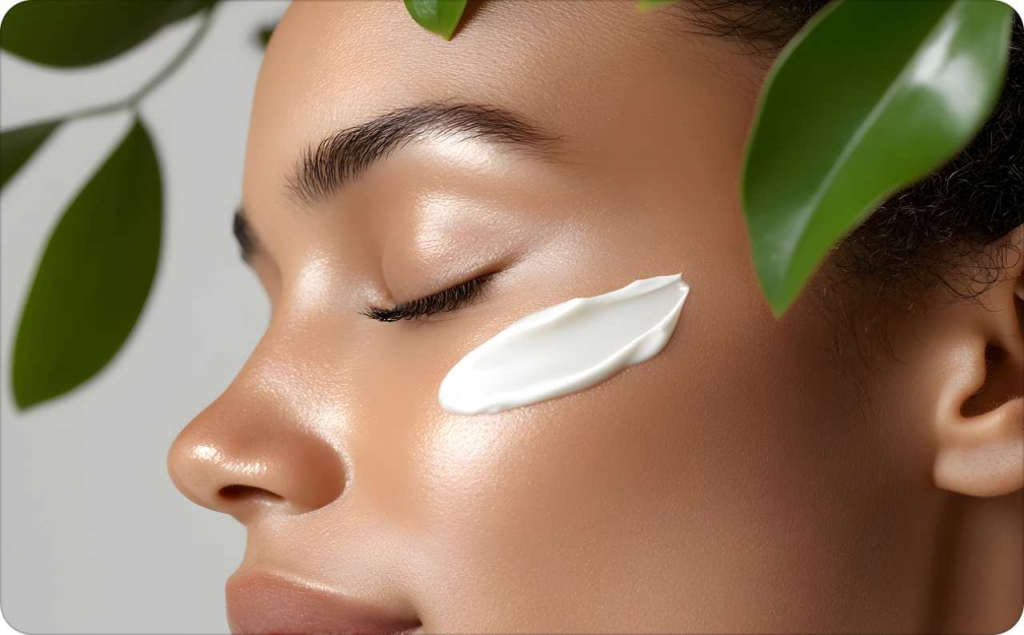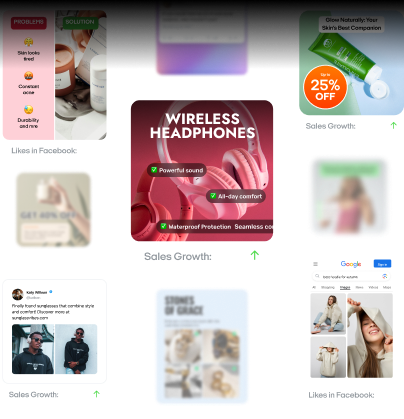Why social media advertising works and how to make it work for your business
Ever wonder why social media ads outperform traditional marketing? Zeely AI explains the psychology behind social ads and how to tailor them for maximum business growth.
The advantages of social media advertising for business start with scale: 5.17 billion people, about 64% of the planet, use social platforms in 2025, and analysts expect that figure to pass six billion by 2028. With that audience on tap, the biggest benefits of social media ads aren’t clicks; they’re conversions you can tie to every dollar.
Why is social media advertising effective? It collapses the path from discovery to purchase faster than any other digital marketing channel across Facebook, Instagram, and TikTok. To prove it, we’ll unpack six core advantages using an Outcome ➜ Pain ➜ Strategy ➜ Metric playbook:
- Outcome: Increase brand visibility, drive engagement, optimize ROI
- Pain: Low conversions, wasted budget
- Strategy: Laser-focused audience targeting, live customer engagement, data-driven analytics
- Metric: Revenue, cost-per-acquisition, lifetime value
Expect crystal-clear tactics busy marketers can deploy today, no fluff, just steps your CFO will quote in meetings. Ready to stop feeding the click monster and start banking measurable results? Let’s dive into why paid social still rules the growth game.
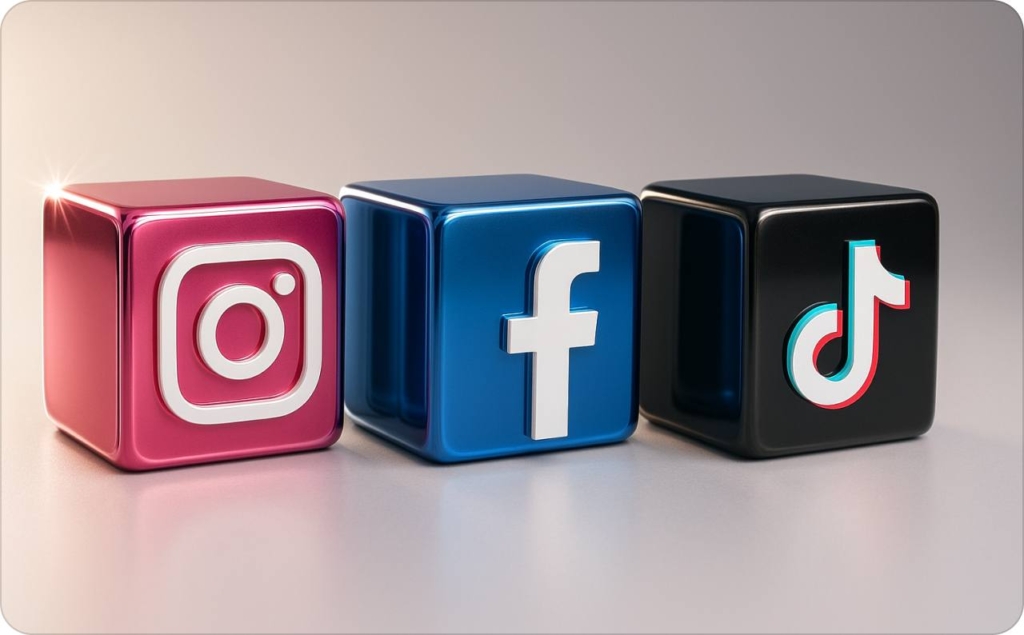
Social media ads in 2025 – why they still matter
The evolving role of social media in digital marketing
How has social media advertising evolved, and why does it still matter in 2025? Well, social media advertising matters because evolving digital marketing trends continue to reshape how you connect with audiences. If you think social ads have peaked, reconsider — advanced AI targeting and next-gen video formats have reinvented their future.
An AI ad creator for social media platforms like Facebook, TikTok, and Instagram empowers businesses to design high-converting, engaging advertisements in minutes. By analyzing trending content styles, the AI automatically generates tailored visuals, ad copy, and formats optimized for each platform. This streamlines the ad creation process, reduces costs, and ensures consistent branding — helping marketers launch eye-catching campaigns that resonate with their audience and drive better results across social channels.
Platforms like Facebook and TikTok now use cutting-edge AI tools to personalize ads instantly. These futuristic innovations deliver real-time marketing and mobile ads, providing richer audience insights than static campaigns ever could. Forbes even identifies 2025 as the tipping point when dynamic, self-optimizing video ads become standard, backed by powerful generative-AI technologies from Amazon and Meta.
This digital innovation is paying off. Brands spent nearly $250 billion on social advertising in 2024 alone, which is up 15% year-on-year, because these ads work. You can now launch a campaign, test multiple creative variations, and let the platform automatically assemble winning elements.
Take advantage of this shift by auditing your current ad library. Break down your ads into modular parts — headlines, images, calls-to-action. This modular structure lets platforms continually remix ads for maximum relevance.
What makes social media more cost-effective than traditional ads?
Many business owners struggle with traditional ads’ rising costs and disappointing returns. When comparing social media vs traditional advertising, social wins hands-down as the most cost-effective digital ads solution.
Numbers make it clear. A broadcast or FAST-channel TV slot often costs around $10–$15 per thousand impressions. In contrast, Facebook CPMs average only $1–$3, with clicks typically under 50 cents each, as reported by Neil Patel. This means you spend far less to achieve superior audience reach and measurable results.
But lower costs are just part of the advantage. Social media’s superior targeting lets you use demographics, intent signals, and real-time behaviors. Traditional ads still broadcast broadly; social pinpoints audiences ready to buy, aligning with how consumer attention increasingly shifts online.
Advanced digital metrics allow you to track ad performance instantly. Instead of waiting months for Nielsen ratings, you get immediate feedback. If an ad underperforms, pause it instantly, saving money and refining your messaging continually.
Ready for a quick test? Shift 10% of your traditional media budget to a mirror-message Facebook campaign. Track the cost-per-acquisition for two weeks. Brands typically see CPA shrink by 30% or more, proving the efficiency of social ads and justifying even bigger budget reallocations.
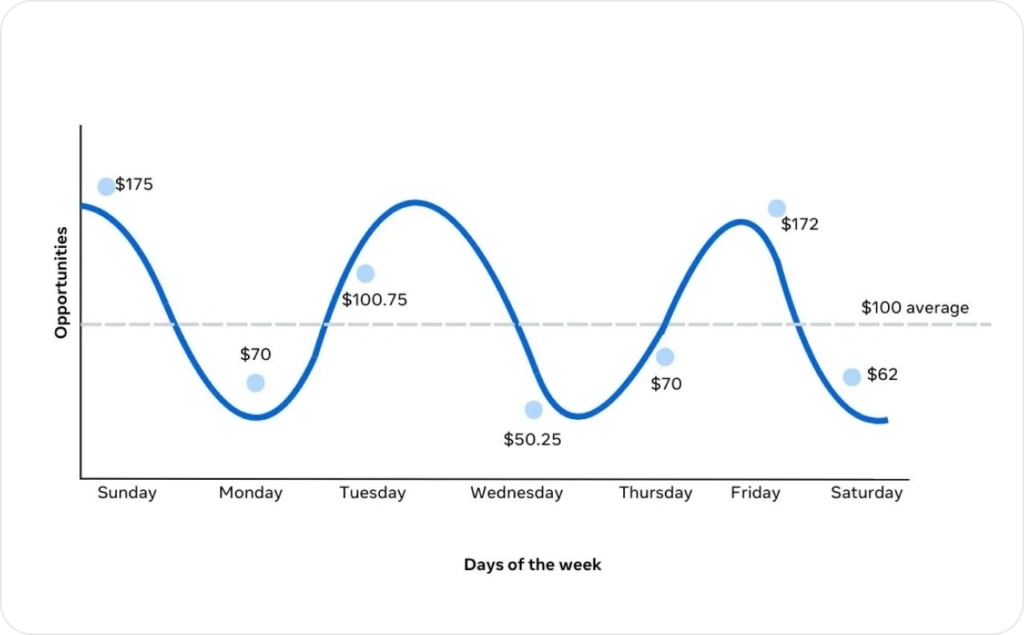
Photo source: Facebook
Which business models benefit most from social advertising, and how?
Many companies struggle because they rely on generic social strategies rather than industry-specific ad optimization. Successful brands, however, tailor their approach explicitly to their business model, accelerating growth and boosting online conversions.
- B2B social media advertising thrives on precise targeting, especially on LinkedIn. According to Forbes, 84% of B2B marketers choose LinkedIn as their top platform for content marketing and lead generation. Firmographic filters transform your reach, ensuring white-paper ads appear to executives with real buying power, not junior staff, making your budget count.
- For e-commerce ad success, social commerce offers explosive opportunities. TechCrunch predicts the U.S social-commerce market will hit $99 billion by 2025, growing 25% each year. Shoppable livestreams on TikTok and Instagram collapse the buying journey into a single swipe, ideal for impulse-driven verticals like fashion or consumer packaged goods. This streamlined experience scales your conversions effortlessly.
- In SaaS customer acquisition, retargeting loops nurture leads systematically. Ads shift from product demos to nurture messages and then free-trial CTAs. This low-cost, high-efficiency ad cycle leverages dynamic creative assets, like in-app screenshots updated instantly as new features launch, to continually optimize performance and ROI.
6 core advantages of social media advertising
Advantage 1 – unmatched brand visibility across demographics
Social media delivers brand visibility across demographics because every age group already scrolls a “home” feed. Gen Z discovers products first on TikTok, about 77%, and Instagram is about 74%, both now beating Google for shopping search.
Meanwhile, 84% of Gen X still checks Facebook daily, followed by YouTube and Instagram, giving brands video and community touchpoints in one place. Boomers mirror that pattern, with Facebook and YouTube commanding the highest session time.
Traditional media forces marketers to choose between a youth channel or a mature-audience outlet. The result is partial reach, fragmented messaging, and wasted impressions. A cosmetics brand that buys linear TV may never appear in a Gen Z feed; a fintech startup that pushes only TikTok could miss Boomers controlling 50% of U.S. household wealth.
Fragmentation stalls market penetration and inflates cost-per-acquisition because each demographic must be bought twice — once for awareness, again for action. Social media’s unified ad stack removes that double spend by letting you serve age-specific creative inside a single campaign ID.
Start with an audience map:
- TikTok hooks for Gen Z
- Instagram Reels with product demos for Millennials
- Facebook video explainers for Gen X–Boomers.
Set placements to “Advantage+” or equivalent so the algorithm tests format, headline, and CTA variations automatically.
This alignment boosts organic reach signals — shares, saves, and comments — because each demo sees content built for its consumption pattern. Brands that follow this discipline typically record a 15-point lift in social media brand awareness within four weeks, according to Sprout Social benchmarks.
Upload a CSV of your highest-value customers and let Meta create 1% Lookalike Audiences. In AdEspresso tests, these hyper-similar cohorts cut cost-per-acquisition by 70% versus broad targets, while larger 10% lookalikes scale reach for branding phases. Layer dynamic placements so Meta or TikTok’s Smart Delivery remix visuals and copy per user profile, sparking audience engagement at scale without extra design hours.
Brands that pair age-tiered creative with 1% lookalikes typically shave uCPM by 25% in seven days while lifting ad-recall 12–18 points, confirming efficient, full-market coverage without budget bloat.
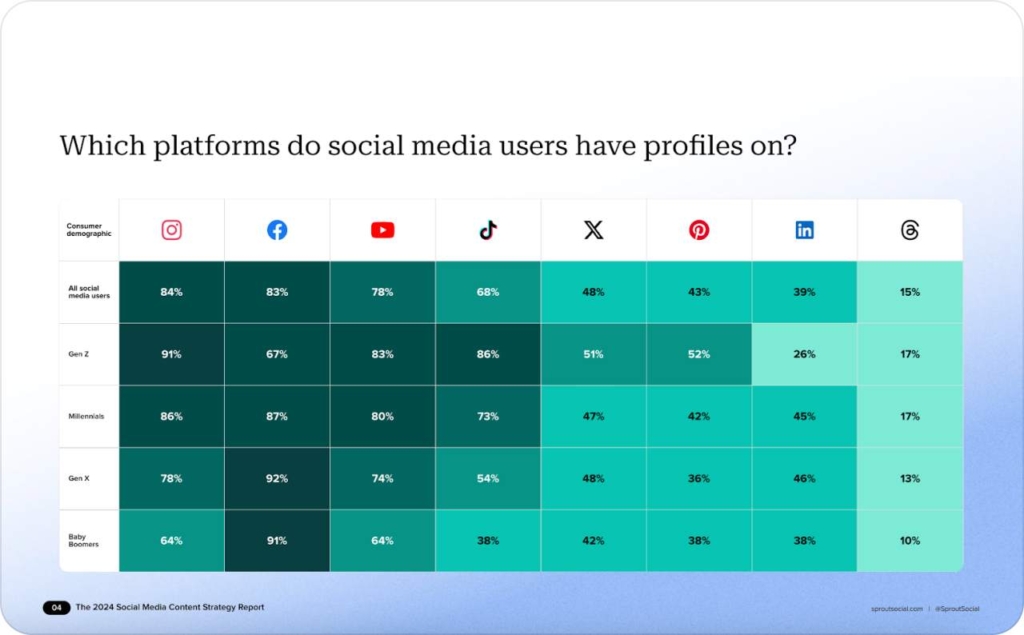
Advantage 2 – laser-focused targeting for better conversions
Broad targeting bleeds cash; a single tweak can stop the leak. Gaming brand Paf replaced wide audiences with a Meta Custom segment plus a 1% Lookalike and sliced cost-per-action by 3.6× in a certified lift test, proving that refined segmentation converts impressions into revenue instead of wasted reach.
Upload past purchasers, email subscribers, or 75% video-viewers and let Meta’s demographic, event, and engagement filters surface micro-segments already primed to buy. Advertisers using these custom audience strategies report higher click-through rates and a sharp drop in acquisition costs because the platform automatically zeros in on high-intent users instead of casual scrollers.
True social media targeting combines affinities rather than lists them. Pair “outdoor runners” AND “energy-bar shoppers” to keep relevance high while volume stays healthy. Independent tests show that interest layering lifts return on ad spend and filters out window-shoppers without choking scale — exactly the balance precision marketers need for sustainable conversion optimization.
If you sell on Shopify, its Audiences feature exports pixel-verified buyer lists directly to Meta, Google, and TikTok. Early adopters see up to 50% lower customer-acquisition costs, proving that aggregated first-party data can outperform platform-only targeting when prospecting at speed. Seed a Custom Audience with your top 1000 customers. Spin a 1–2% Lookalike to add scale without losing intent. Layer two or three high-signal interests or behaviors. Exclude recent purchasers to prevent redundant impressions.
Monitor conversion-rate lift, cost-per-conversion, and incremental ROAS. If all three climb, widen the Lookalike; if they dip, tighten your layers. Precision marketing isn’t magic — it’s measurement.
Advantage 3 – high ROI on a flexible budget
Small spend, big return. Instagram’s median cost-per-click sits between $0.50 and $1.00, while CPMs hover around $3.00. These figures let even a $10-a-day test stretch every dollar without risking cash-flow. Pair that low entry cost with Facebook’s 9.21% average conversion rate and the math gets exciting fast: one qualified click out of ten can already pay for the next nine.
Home-goods retailer Seltzer Goods launched just two Meta ads, one on Facebook, one on Instagram, using a $40-a-day budget. Thirty days later they posted a 9.68× return on ad spend, a $4.87 cost per acquisition, and a 785% jump in revenue. The takeaway: you don’t need enterprise dollars to maximize returns; you need disciplined targeting and a willingness to let the algorithm optimize.
Start with the “5% rule”: allocate five percent of monthly revenue to paid social, then reinvest a portion of profit as ROAS rises. Industry planners recommend $100–$500 per month for small businesses and $500–$5 000 for mid-size brands — a glide path that keeps cash burn sustainable while momentum builds.
Track three metrics to prove efficiency at every stage: cost-per-click, find the cheapest quality traffic, cost-per-conversion, and incremental ROAS. When all three trend positive, raise the ceiling in 10% increments; if any falter, pause the lowest-performing ad set instead of upping spend. This iterative loop lets marketers optimize budgets continuously, ensuring each extra dollar buys profit, not just impressions.
Advantage 4 – real-time engagement with your buyers
Most consumers expect a brand response on social within 24 hours or less; slow answers feel impersonal and push shoppers elsewhere. At the same time, 48% of people say they now interact with brands on social more than they did six months ago, proving audiences are primed for two-way dialogue. Meeting that demand turns fleeting attention into repeat business and higher ad relevance scores.
Chatbots already power 36% of brand accounts and have lifted sales by up to 67% thanks to always-on Q&A that ignites loyalty at scale. Live formats multiply the effect: 82% of viewers prefer real-time video over static posts, and 73% say they’re more likely to purchase after a livestream demo. Even outside special events, AI-assisted comment replies drove a 42% jump in social-referral sales last holiday season.
Track three indicators: Average Reply Time target, < 60 minutes, Engagement Rate per post, and Assisted Conversion Rate from social sessions. Sprout Social’s Inbox Team Report makes reply time easy to audit, while platform attribution tags reveal which conversations convert.
If all three climb, double down on live chats or scheduled streams; if any stall, refine bot scripts or reduce comment-response lag. Real-time engagement isn’t a gimmick, it’s the feedback loop that keeps ad spend efficient and customers coming back.
Advantage 5 – full-funnel lead generation & retargeting
Social platforms act as an end-to-end social media conversion funnel. You can capture leads without ever sending visitors off-site. Facebook Instant Forms and LinkedIn Lead Gen Cards push prospect data straight to your CRM, eliminating landing-page drop-off. This frictionless hand-off matters: 68% of marketers say social media delivers more leads than any other channel, confirming its frontline role for top-of-funnel growth. Align each creative with funnel intent — snack-size explainer for awareness, carousel case study for evaluation, limited-time offer for purchase — and the platform keeps nurturing automatically. The result is a continuous, closed-loop pipeline that plugs the leaks traditional multi-channel journeys suffer.
After first touch, switch to lead generation retargeting strategies that flash reminders exactly when intent peaks. Meta studies show well-timed retargeting ads can lift conversion rates by up to 150 % versus cold audiences. Build a three-tier stack — recent site visitors, 75 % video viewers, cart abandoners — and serve each segment a context-matched CTA: download the guide, claim a discount, or finish checkout.
Brands adding dynamic product ads to this mix report a 33% revenue jump thanks to personalized follow-ups. Track Cost-per-Lead for efficiency, Retargeting Conversion Rate for effectiveness, and Incremental ROAS for profit. When all three climb, widen the look-back window; if any slip, refresh creative or tighten audience rules. This data loop lets you retarget smartly and turn every past click into bankable revenue.
Advantage 6 – data-driven decision making with robust analytics
The 2025 Sprout Social Index shows 65% of marketing leaders demand proof that every social campaign maps to business goals. Meta Ads Manager and Google Analytics 4 now stitch impression-to-revenue paths into a single view, so teams can trace each click’s cash value instead of guessing. Replacing vague “brand-lift” reports with hard KPIs lets you surface wasted spend early and redirect budget to tactics that drive real profit.
Google cemented data-driven attribution as the default in GA4, using machine learning to assign credit across every touchpoint. Retailer Líder switched to GA4’s cross-channel model and slashed cost-per-acquisition 85% while boosting conversions 18×, proving algorithmic crediting pays off.
Similar lift studies in Meta’s Conversion API show incremental sales rise when audiences are optimized by purchase signals, not vanity clicks. Robust attribution doesn’t just explain results — it validates decisions and gives finance a clear line from ad to revenue.
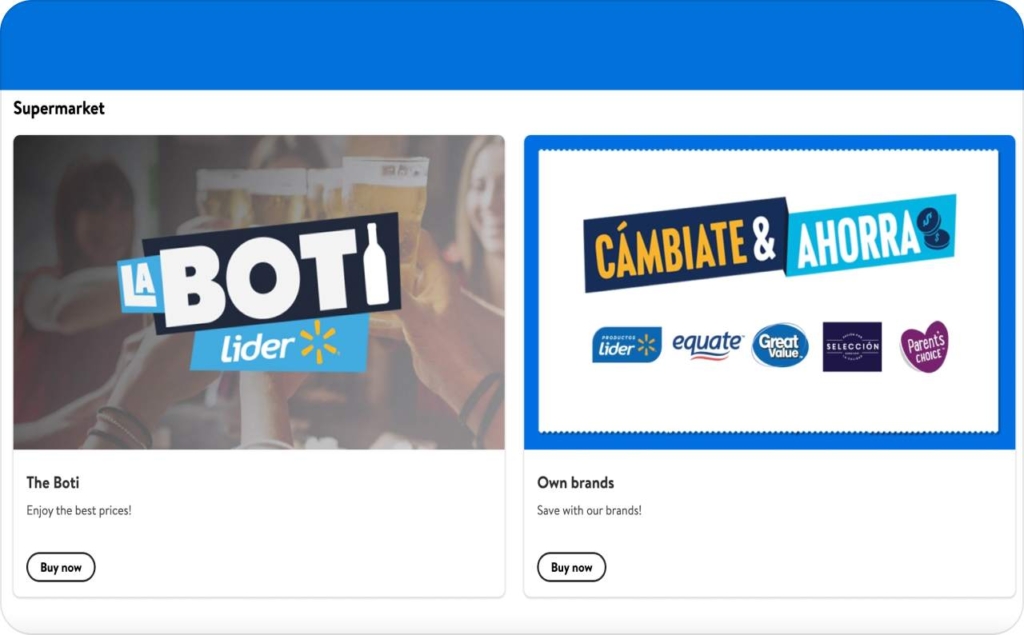
Photo source: Líder
Common pain points and how to fix them
Getting clicks but no conversions? Here’s why
High click counts with no sales often mean you’re attracting the wrong kind of attention. In one case, a boutique launched Instagram Story ads that pulled in thousands of taps, but carts stayed empty. The issue? Low-quality traffic from accidental swipes, autoplay views, and curious users who weren’t ready to buy. Use Instagram ad generator with AI to effortlessly design visually stunning, high-performing ads tailored to your audience — saving time while boosting engagement and conversions.
Start by dissecting your data. Filter out sessions that lasted less than three seconds, they’re often bots or bounce traffic. Then, match your ad’s promise with your landing page visuals and copy. If your ad promotes a red dress, the landing page should show that red dress immediately. Finally, retarget warm users — those who scroll halfway down your product page with timed offers. That small tweak brought this boutique measurable daily conversions without increasing spend.
Wasting budget on poor targeting? Try these adjustments
Broad targeting can quietly eat your entire budget. One café promoted “food-lover” ads to a whole city and saw no foot traffic in return. Why? The campaign lacked geographic and behavioral focus.
To refine your targeting, start by uploading your loyalty app list and build a 1% Lookalike Audience of local customers. Then, narrow down interests: combine tags like “latte art” and “remote work” to reach people who actually hang out in cafés. Lastly, limit delivery times to business hours if you’re closed by 6 p.m. These three moves didn’t increase the café’s budget, but they doubled midday visits, proving that precision always outperforms scale in social media advertising.
Trouble measuring ROI? Use these attribution models
If you’re only using last-click attribution, you’re missing the full story. A SaaS startup made this mistake, cutting Facebook ads after reports showed low ROI. But a week later, trial sign-ups collapsed. Why? The first ad impressions weren’t being credited for influencing purchase decisions.
To track performance accurately, switch to data-driven attribution in Google Analytics 4 and connect Meta’s Conversion API. Set up tracking for events like demo requests, trial starts, and paid signups. When this startup analyzed performance across the full journey, they found that Instagram Reels worked best at the top of the funnel, while retargeting closed the deal. Reallocating spend accordingly brought their cost-per-trial back into the green within 14 days.
Real-world tactics to maximize your social ad results
Launch a $500 test campaign without guesswork
A $500 test campaign gives you room to experiment without risking your full budget. Split your spend like this: $300 for ad delivery, $150 for visuals and copy, and $50 for testing different audiences. Start with one platform — say, Meta — and choose a conversion-focused campaign objective.
Example: Create two Facebook ads promoting your online candle shop. One ad uses a calming photo with the headline “Relax starts here.” The other features a customer testimonial video with “Why I switched to soy.” Run both for 5–7 days, targeting your email list or a 1% Lookalike.
Use Meta Pixel or GA4 to track cost per lead or checkout completions. When one ad performs better, or lower cost per purchase, pause the weaker one and scale the winner slowly. Keep notes on what worked — was it the video, the CTA, or the audience?
Build ad creative that actually converts
Good ad creative doesn’t need to be expensive, but it has to grab attention and drive action. Use the classic framework: Hook → Value → CTA. Your hook grabs the scroll, the value explains the benefit, and the CTA tells them what to do next.
Example: A skincare brand posts a 6-second video ad. Hook: “Still breaking out?” Overlay Value: “Clear skin in 2 weeks — backed by dermatologists.” CTA: “Shop now.” That simple structure leads viewers toward action.
Keep your visuals bold, your copy short, and your layout mobile-friendly. Carousels? Use them to tell a story: Slide 1 shows the problem, Slide 2 shows your product in use, Slide 3 gives the discount. Want proof? Run the same product as a static image and a short video — compare CTR and ROAS after three days to see what converts better.
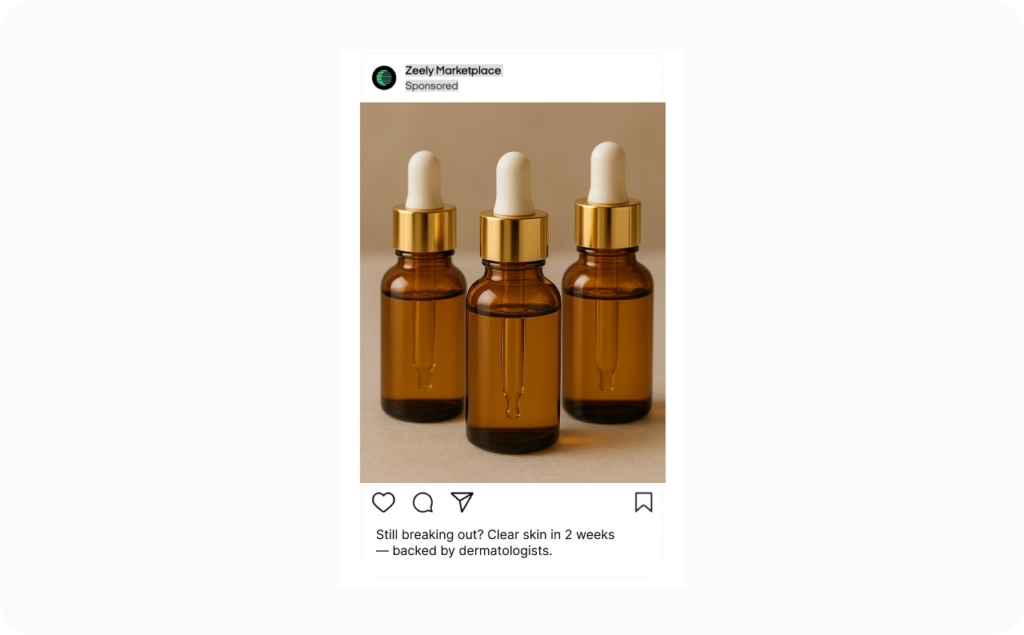
Scale performance without overspending
Once your campaign is working, resist the urge to simply triple your budget. Instead, scale with structure. First, confirm your key metric is at least 20–30% better than your target. Then, duplicate the winning ad set and increase the budget by no more than 20%.
Example: Your dog treat ad is getting sales at $3 per purchase and your goal was $5. Duplicate the best-performing ad set, raise its budget from $20 to $25 per day, and monitor for three more days.
Turn on Advantage+ Placements on Meta so the platform delivers to the best-performing placements, like Reels or Stories. If performance holds, repeat the budget bump. Monitor frequency, ROAS, and CPC. If frequency hits 3 and clicks drop, swap in new creative. Use Campaign Budget Optimization to let Meta adjust spending across ad sets automatically, keeping your results high and your spend efficient.
Tools, templates, and benchmarks
Here’s a simple breakdown of the best platforms, tools, and performance metrics to help you run smarter social ad campaigns — whether you’re in e-commerce, SaaS, or B2B marketing.
Choosing the right social ad platform
| Platform | What it does best | Best for | Why you’d use it |
| Meta: Facebook + Instagram | Strong targeting, great for retargeting, conversion tracking | e-commerce, service-based businesses | You want to track every click-to-sale and retarget visitors who didn’t convert. |
| TikTok | Fast organic reach, video-first format, low cost CPM | Product launches, Gen Z, fashion, beauty | You need attention fast with thumb-stopping video content. |
| B2B targeting by job title, company size, industry | Consultants, SaaS, enterprise lead gen | You sell to decision-makers or need leads in specific business roles. | |
| High intent search, evergreen content visibility | Home décor, DIY, food, retail | You want long-lasting visibility for visually appealing products. |
Must-have tools for better targeting & optimization
| Tool | What it helps with | Why it’s useful | When to use it |
| Meta Ads Manager | Building, launching, and tracking Meta ad campaigns | It’s the core dashboard to run Facebook/Instagram ads | Always — required for Meta campaigns |
| Google Analytics 4 | Tracks full user journey before and after ad click | Helps you see if clicks actually turn into sales or leads | When measuring performance across site traffic, ads, and conversions |
| Sprout Social / Hootsuite | Post scheduling, analytics, centralized social control | Manage multiple platforms in one place, schedule content, analyze trends | When running organic + paid social together |
| AdEspresso | Easy A/B testing for Meta ads for creatives, headlines | Quickly see what copy or creative performs best | When testing ad variations on a budget |
KPIs That Actually Matter by business type
| Business type | Must-track KPIs | Why they matter |
| E-commerce | Return on Ad Spend, Cost Per Purchase, Add-to-Cart Rate | Tells you which ads are profitable and which drive actual sales |
| SaaS | Trial-to-Paid Conversion Rate, Cost to Acquire Customer, Lifetime Value | Helps you track real revenue, not just signups |
| B2B / Lead Gen | Sales-Qualified Leads, Cost Per Lead, Funnel Drop-Off | Shows how efficiently you’re turning ad spend into business-ready leads |
Simple Example for Clarity
Let’s say you’re a SaaS startup:
- You run a video ad on LinkedIn targeting “Operations Managers at companies with 50–500 employees”
- You track CPL and Trial-to-paid conversion rate in GA4
- You A/B test the CTA “Start free trial” vs “Book a demo” using AdEspresso
- You adjust spend weekly based on which ad gives you more conversions at a lower cost
This stack helps you spend smart, test fast, and optimize for growth.
Conclusion
Social media advertising still delivers the fastest path from scroll to sale, but only if you use it right. With smarter tools, better creative, and clear performance metrics, any business can turn ads into real growth. Platforms evolve, but the formula stays the same: test, track, optimize. Whether you’re just starting out or ready to scale, Zeely AI helps you launch smarter, spend wiser, and win more automatically.
Also recommended
